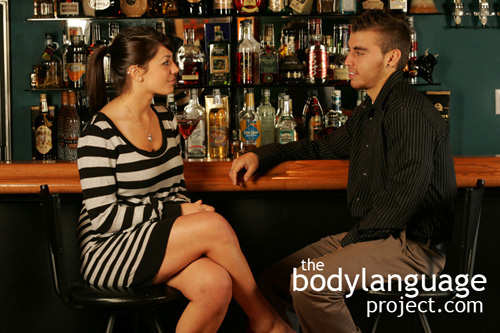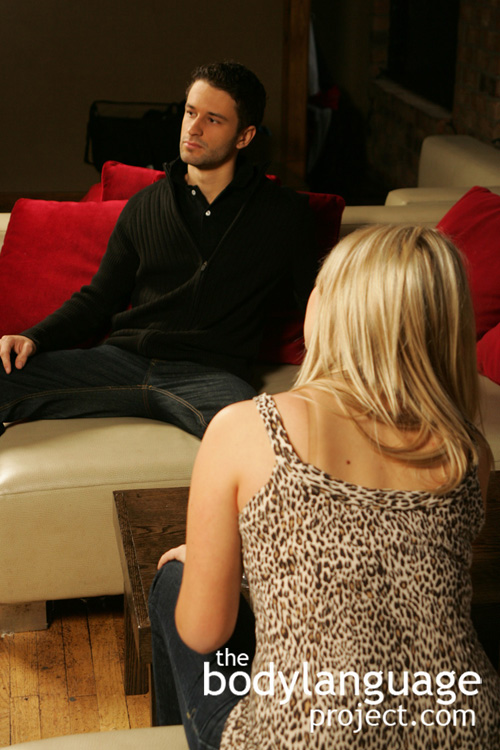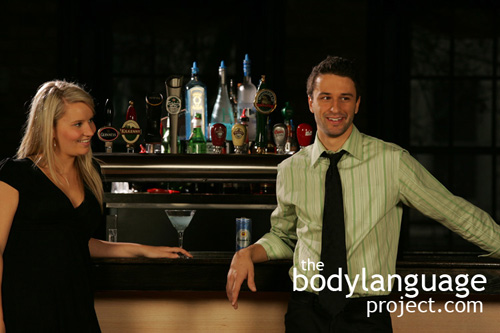An extreme form of closed posture is the fetal position. While it might seem far fetched to expect someone in your company to have this posture, it does occur although in more abbreviated adult acceptable ways. While at an informal party, for example, a women in might find herself hugging her knees at the end of a couch. To her, this feels comfortable, which is why she does it, but it reveals her true emotions. When in a public she is timid and reserved so she curls up in a ball. The abbreviated form of this position, of course, and one that is more acceptable in public is to pull the limbs in closer to the body and across the center-line as in the “self hug”. With age, we learn that taking up the fetal position, like thumb sucking, is not an acceptable way of dealing with our insecurity so we drop the extreme form of the gesture in favour of more subtle cues. Playing with the hair, rolling it around a finger, sucking on it, or a pen, or other oral fixations are also juvenile coping behaviours that become unacceptable, although often still continue, into adulthood.
Tag Archive for Couch
The Meaning Of Leg Crossing
by Chris Site Author • March 5, 2013 • 1 Comment
The legs are equally as expressive as the arm in terms of the meaning they convey. This is largely because the arms are frequently busy doing other task oriented things whereas the legs usually remain idle free to express hidden thoughts. Of course, the legs also have their share of work to do, but when sitting or standing still they have a tendency to leak information. We also pay less attention to our legs because they move less freely putting them further away from our consciousness. Perhaps we feel that because our legs can only do so much we need not pay them any mind and so reason we ignore them.
The legs therefore, are a great indicator of true thoughts and feelings. For example, we might look to the legs to verify interest. The legs crossed toward something or someone indicates thoughts and shows an attraction in the direction. In other words the legs are propelled in the direction in which we think. Couples that have a strong relationship will cross their legs toward each other, enemies will cross away, context permitting of course. Lovers sitting on a couch together with their legs crossed toward each other, bodies leaning inward, with their arms meeting over the backs of the couch are said to be in a “loving circle.” This is not a term reserved for just intimate couples though, it can also apply to family, close friends and even associates, both male and female. It represents a likeness of mind – agreement. Caution is required at this point, since not everyone is equally able or willing to cross their legs in either direction. Over time, we tend to develop greater flexibility in one direction, or the other, simply through habit, so it’s not always a valuable signal if a person crosses their legs away from someone else. If they lean and cross away from each other, then these two clues, in context, might mean something is worth exploring further.
It has been noted in several studies that the amount of movement that the feet undergo while lying significantly increases, and that these movements are below the level of consciousness. It’s fairly easy to monitor our arms and (with limited success), our facial expressions, but it’s something else to monitor a distant part like our feet. The leg tap, where the hand rhythmically taps the thigh can be done out of fear or deceit, even out of fear of being caught, uneasiness and even boredom, depending on the remaining set of cues in a cluster and on the particular context by which they occur. What we do below the belt is out of sight and out of mind!
Legs
uncrossed is a signal of openness, acceptance and signal of being easy going. This is of particular importance as it pertains to women, as it can taken as a sexual signal or invitation, making women appear easy, “loose” or at best crass or improper. Sharon Stone in the movie Basic Instinct sent a clear message as she slowly uncrossed and re-crossed her legs while being interrogated. Women wishing to appear dominant will find this posture comfortable, but it will be accompanied by other male typical gestures such as throwing an arm over the back of the chair to take up more space and loud boisterous behaviour.
Men, on the other hand, have the benefit of using the uncrossed legs signal for more than one reason. Men can have their legs uncrossed to display a signal of dominance and authority which is a welcomed natural signal from men, or it can be used as a signal to appear open. In men, the meaning of the leg spread is determined by its context and the manner in which it occurs. Men in seated positions spread their legs as a dominance display as it puts the genitals out for everyone to see. This is one of the gestures that makes use of the exercise of imagining people fully nude. What would you think of a guest that sat down in your favourite chair and tossed his leg over the arm rest? Would you think him any less belligerent if he had done it at his own house? The leg over the chair is as overt a leg spread message as you will get.
The degree to which leg spreading happens is important in both sexes. Spreading is positively correlated with dominance display. That is the greater the leg spread, the greater is the dominance display. The legs cocked, so to speak, at shoulder width while seated, is comfortable and natural even for both sexes, but once the legs break that distance, appear much less covert. Once the legs meet their maximum angle, it is as if the genitals are yelling at the top of their lungs through a loudspeaker begging to be noticed! Legs in the figure four where one ankle is raise and placed on top of the knee opposite is an abbreviated leg cross which is less dominant. We cover this later in the chapter. The legs can also be cross tightly with the legs nearly parallel or with the leg over the knee. This is a reserved posture and shows a respectful, polite and proper attitude.
In a standing position, legs spread at or slightly beyond shoulder width signals dominance in a more acceptable way. In fact, having the legs uncrossed while standing is the most appropriate way to stand since it appears open, accepting and confident. Crossing at the ankles, as we will see later, shows a reserved mind and is therefore a closed posture. We must be careful with reading leg information since most everyone has a preferred way to cross them, but if we watching their movement across time and across context we can pattern specific people. We should never assume that any and all signals, especially leg crossing, has universal meaning across all people.
Being Opened And Closed Through The Legs And Arms
by Chris Site Author • March 5, 2013 • 3 Comments
Throughout this chapter being “open”, refers to a frame of mind that is willing to accept information, to hear others out and to consider taking action whereas a closed mind, or being closed indicates the opposite. As mentioned previously, having an open and receptive mind is indicated in body language through the absence of closed postures.
It has been shown that frowning requires more muscles and effort than does smiling and so naturally our default facial expression is the smile. Similarly, openness as it relates to body language is the default mode because a relaxed body requires less effort than one that is tensed or closed. To take a negative posture, we must actively close our bodies off requiring effort and to exercise effort we need motivation. In this case, motivation can come from any fearful or unwanted stimulus that precedes a fight or flight response. That is to say that, closed body language are the postures we while see as a negative decision is being analyzed and so is a predictor of a bad outcome.
Being completely open allows us take our most comfortable position, such as what we might do on a couch or in bed in our own house. We might lay our arms out and take up space, put our hands above our heads, spread our legs open or even lay down completely. Having open body postures is akin to being totally exposed to the word and all the harmful things in it, but possessing no fear of harm. Of course, we permit ourselves to hold open postures precisely because we expect nothing harmful to happen. In other words, our bodies are permitted to relax when we are open and contract and tighten when we are closed.
Thus, it takes muscular effort to close the body off whereas open postures occur without action at all. When viewing open body language imagine the extremity of the postures, which as mentioned, can be likened to being on a couch at home. An even more dramatic example is to view open body language as that language exhibited by someone who is intoxicated. Their language is loose, their arms sway freely, they stagger, they have no worries about being ridiculed or attacked and they don’t cross their arms or legs. The cerebral cortex of the drunk, the part of the brain that helps in judgment, amongst other brain centers, is disrupted producing depressed inhibition, increases talkativeness and makes people feel more confident. Alcohol also increases pain thresholds, numbs pain, and makes people feel sluggish because it suppresses the brains ability to function. So for our purpose, the drunk makes a nice example of open body language since he lacks fear, but even if he did, he’d still lack the coordination and strength to carry out a defensive posture.
As a rule of thumb, closed body language happens whenever one of our limbs crosses the mid-point of our bodies. Such is the case during leg and arm crossing. Open postures, on the other hand, happen when the legs and arms remain un-crossed leaving the torso and groin exposed. Of course there are various ways in which the legs and arms can be crossed and these all mean different things which we cover next.
Perpetuating The Smile: On Mirroring And Smiling
by Chris Site Author • March 5, 2013 • 0 Comments
Smiling is contagious and often just by holding a smile others feel compelled to smile as well. Try an experiment for yourself and see just how hard it is to frown when viewing smiles or smile when viewing frowning. You will see that mirroring is a much more natural response whereas holding opposite expressions requires conscious thought. Flashing a smile at random strangers can flood their bodies with positive hormones and brighten their day. Even just holding a smile despite feeling down can help elevate your mood and make you feel better.
We see this exact same contagion with attitudes of those surrounding us. A famous skit on Saturday Night Live involves a character called “Debbie Downer.” The scene is set in a social gathering where the character, at each opportunity, offers a contrarian’s view to what is an otherwise a positive or neutral statement. The effect it has is potent and brings those around her down, hence her name. Persistent negative attitudes in others around us tend to drag down our moods, while optimistic attitudes tend to make us feel better. Although overly optimistic attitudes, just like overly pessimistic attitudes can lead to negative feelings about others as well.
Research has shown that our facial muscles tend to mirror what we see in others and that this reaction is subconscious. While it is possible to control our facial muscles by consciously over-ridding this tendency, most others will simply, by nature, imitate what they see in us. This is why it is so important to, both imitate smiles when seen, and to also avoid holding sour faces especially on initial meetings.
Let’s take the stereotypical example of a married couple; a wife and husband. After a long days work taking care of the children, the husband comes home from his long day with a scowl on his face and plops himself on the couch. He’s had a bad day, and so too has she. Their expressions feed of one another and their attitudes remains negative. What if the husband came home with good news and a big smile? Naturally, his wife would follow and they’d share a nice welcome, both parties willing. If one or the other fails to follow the lead, the entire mood would be soured by the frowning party. Both parties are therefore responsible for deciding the mood.
We often get caught up in daily rituals, especially at home, that we forget to put on a fake smile which is otherwise required at work. We know that we can’t get away with such crass behaviour while away from home and around strangers, so we put on a fake smile despite our mood, but once home we give our faces a break. We know instinctively that we can’t get away with a sour face in public because others will think poorly of us and won’t want to be around us. The freedom to express moods naturally in our own homes can be a blessing, but can also be a drag. Sometimes taking the extra effort can be rewarded so it’s worth a try, especially if the mood has been sour perpetually. So the advice follows that when people around you are in a bad mood, even at home, initiate the smile, hold it persistently and see what happens!









